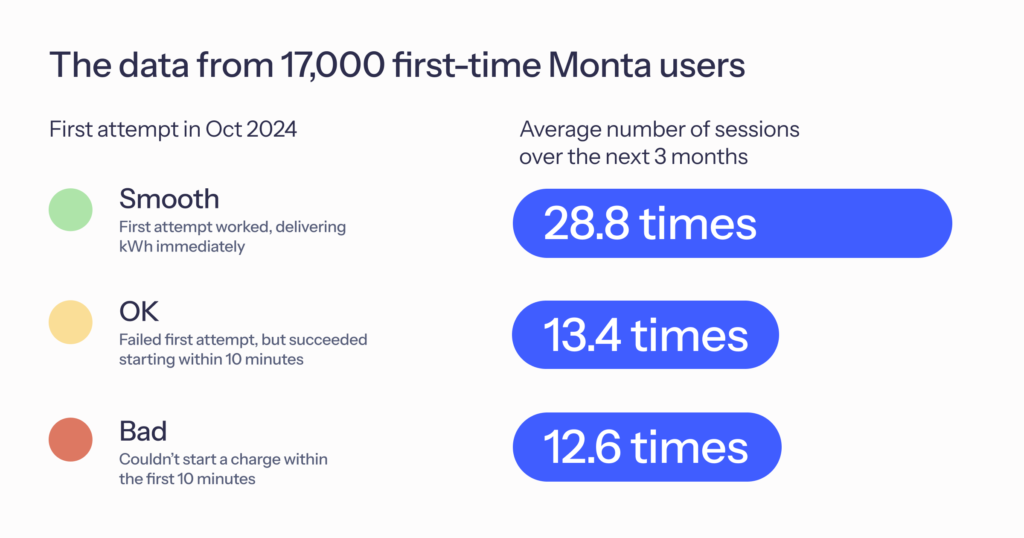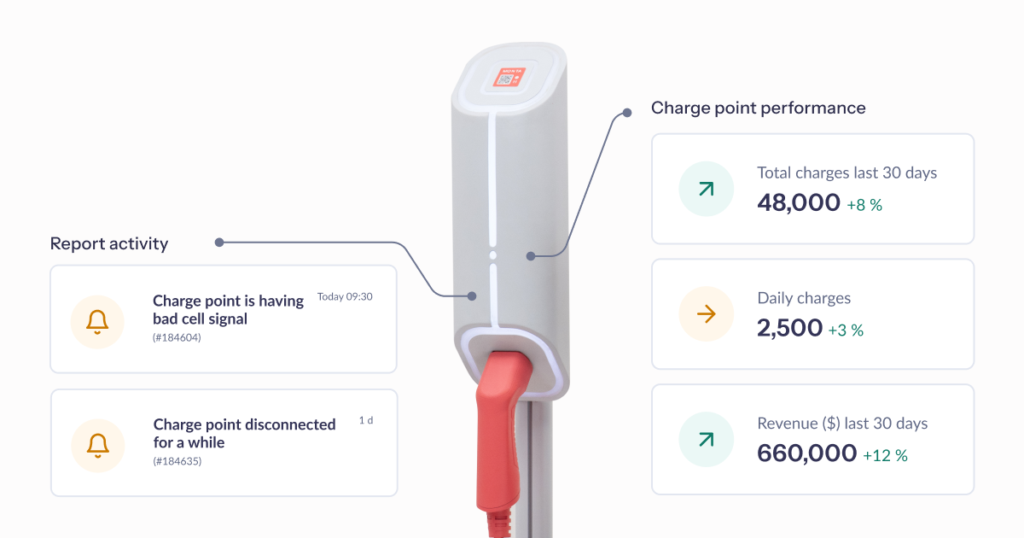
Proper EV charging infrastructure has the potential to speed up electric vehicle adoption, support the growth of clean transportation, and ultimately reduce greenhouse gas emissions. However, it's no small feat to establish an EV charging site, let alone an entire network. And even after the chargers are installed, the real challenge begins—making sure they don’t sit unused.
So once the basics are in place, network operators and site owners can focus on their primary goal: increase utilization. In other words, attract new and returning drivers, and sell as many kilowatt-hours as possible. But right now, it's estimated that 70% of EV charging stations in the United States are underutilized.
So how do top-performing sites and networks reach peak charger utilization? What makes them truly successful?
What to Consider When Ramping Up a Charging Site
From establishing a good reputation in the market to fine-tuning the logistics, the very first charging station often faces a steep learning curve: It can take 12 or more months to reach utilization levels that are on par with mature sites.
By the time operators reach site number 50, for instance, the ramp-up process tends to be significantly smoother and more predictable.
To fully understand EV charger utilization rates and how the US market can maximize usage, we analyzed millions of charges across more than 5,000 chargers. We also interviewed 10 European charging networks to help us benchmark top performers and establish 12 ways to maximize utilization rates.
Whether you’re establishing your first charging site or your hundredth, here are the first three things to consider:
- Attractive location
- High-quality physical user experience
- Seamless software user experience
1. Attractive Charging Location
You know what they say—location, location, location. It’s true for any business, and it's certainly the cornerstone of a successful EV charging station.
When choosing a site, look for areas that already see high traffic, or for planned developments that could see growing demand.
Consider the following types of locations:
- Highways and Rest Stops
Sites near highway exits and rest stops see continuous traffic, especially from long-haul travelers who can charge up, stretch their legs, and ultimately avoid range anxiety. - Urban Centers
Downtown and business districts are hubs of activity. The density of offices and retail spaces means a steady flow of drivers can seamlessly integrate charging into their daily routines. - Retail Hubs
Shopping malls, grocery stores, and restaurants attract drivers looking to combine errands with charging sessions. This creates a mutually beneficial relationship between local businesses and charging sites. - Residential Areas
Establishing sites in neighborhoods addresses the needs of electric vehicle owners who don’t have their own chargers at home. - Workplaces
Large office complexes offer a regular customer base during work hours, meaning predictable, daily usage. - Tourist Destinations
Proximity to parks, landmarks, and beaches not only attracts local users but also benefits from tourist traffic, increasing the site's exposure and utilization.
Grid Capability at Your Charging Site
Last but not least, assess the site's EV charging infrastructure to be sure it can support high power demands without compromising performance. Monta’s load balancing capabilities guarantee optimal usage of your site without costly expansion.
In this example of double dynamic load balancing, a building has 40 amps available, but 10 of those are prioritized for the building itself. If there are two electric vehicles charging, they will split the remaining 30 amps. If there is only one electric vehicle, it receives all 30.
2. High-Quality Physical User Experience
The physical user experience (UX) is probably the first tangible interaction EV drivers have with your charging station, so first impressions are everything.
Here are key things to focus on:
- Seamless Site Navigation
The site should be designed for easy entry, smooth circulation, and quick exits. A well-planned layout minimizes queuing and congestion. - User-Friendly Hardware
Features like lightweight and ergonomic cables contribute to a hassle-free experience, and simple, clear labeling ensures that even first-time users can operate the chargers without guessing. - Optimal EV Charging Performance
If you promote high-speed charging capabilities (e.g., a 400kWh capacity), the hardware must consistently deliver near those performance levels. Underperforming chargers quickly generate negative buzz, so be sure to find the most reliable chargers on the market. - Regular Maintenance
Routine maintenance and testing of charging equipment not only prevents technical issues but also reduces the need for expensive repairs. A platform with proactive troubleshooting can even help you identify issues before they escalate. - Extra Amenities
EV charging site operators can also improve the physical experience by offering Wi-Fi, food and beverage options, and comfortable seating while drivers charge.
By carefully addressing these physical elements, operators can create a charging environment that is efficient and inviting, setting the stage for high utilization and long-term customer loyalty.
3. Seamless Software User Experience
App fatigue is real for EV drivers. A seamless, intuitive—and even app-less—experience at the charger can significantly boost customer satisfaction and encourage repeat usage.
Here are the key areas to focus on:
- Flexible Payment Options
Drivers have varying preferences when it comes to paying. Whether it’s through a dedicated app, RFIDs, roaming integrations, payment terminals, or QR code payments, be sure that each method provides a consistent and smooth experience. - Intelligent Charging Features
You don't want to miss out on potential traffic. Pick a robust software with a reservation system and SmartQueue capabilities. This allows drivers to book charging stations ahead of time and receive notifications as soon as one's ready. - Intuitive Design
Quick onboarding, clear navigation, uncluttered layouts, and step-by-step guidance are critical. Whether users are plugging in first or starting the session in an app before connecting, your software should support both workflows. - Real-Time Feedback
Provide timely status updates on charger availability, session progress, and any potential issues. Transparent, real-time information reassures drivers and helps them plan their charging sessions efficiently.
So how important is the first impression, really?
We looked at 17,000 first-time Monta users and the average number of sessions they completed after their first charge. The data was clear: Adoption more than doubled for users whose first charge went smoothly.

By investing in a polished software experience, you not only enhance driver satisfaction but also streamline your operations, helping you gain higher network utilization and stronger brand loyalty.
Using Data to Optimize EV Charger Utilization and Adoption
With the right platform, EV network operators and site owners can use analytics to spot trends and patterns in user behavior.
Monta's hardware-agnostic solution is more than a charge point management system—it gives business owners a competitive advantage in this EV charging market. From qualitative data like kWh sold on a specific charger, to quantitative data like driver feedback, business owners can directly improve the customer experience and the overall efficiency of their operations.
And with features like charge subscriptions, load balancing management, and dynamic pricing operators and site owners can look forward to higher charger utilization and customer satisfaction, ultimately leading to more revenue and long-term loyalty.

Whether a site includes public, fleet, or semi-private chargers, Monta gives operators and site owners complete control of chargers and direct insight into EV charger utilization rates.
9 More Methods to Increase Utilization at Your EV Charging Station
While location, physical UX, and software UX are the top three areas that impact utilization rates, there are more pieces to the puzzle.
Other strategies for attracting drivers to your EV charging stations—and retaining them—include clear pricing, incentives like discounts, loyalty programs, and rewards, and establishing relationships with local media and influencers.
More concretely, here are nine more things to consider:
- Proper customer support
- Dynamic pricing
- Local fleet agreements
- Loyalty and charge packages
- Displays with prices and availability
- Cross-selling with local businesses
- Promotions
- Local PR
- Paid advertising
Get detailed, actionable tips about all 12 ways to maximize charger utilization in our free white paper, What Drives DC Charger Utilization.
